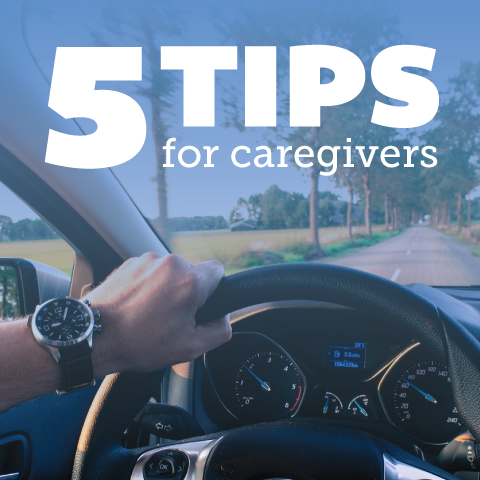
5 Tips for Driving with Dementia
When you hear the word “driving,” what comes to mind? Speeding down the open road, convertible top down, wind in your hair, driving off into the sunset? We’d all like to think of driving as idealistic, but in reality, it’s often more like stoplights, tailgaters, brake lights, and really just a necessity for getting to work and running errands. It is this commonplace driving situation that can become the most dangerous as dementia progresses. Delayed reaction times, poor judgment, inability to stay attentive behind the wheel, and frustration can be highly problematic in the stop-and-go traffic of Northern Virginia. So when is it time to stop driving?
What are the signs?
For many of us, the loss of driving ability is a huge loss of independence – it’s not something to give up lightly! For those recently diagnosed with a memory impairment, they may be able to continue to drive safely for some time, especially if they have a long driving history. But as a loved one, keep an eye out for signs that it may be time to cut back on driving, or stop altogether. Look for trouble paying attention - things like missing traffic signs, or making errors at intersections; difficulty making sound judgments –following too closely, problems merging, or hitting a curb; delayed reaction times – close calls with traffic lights changing, or braking cars; and even directional difficulties – forgetting how to locate familiar places or returning from a routine drive later than usual. You may want to consider keeping a log of any troubling incidents. This will help you look for patterns, and see if the incidents are isolated (we all have our bad days!), or if problems are becoming progressively worse.
Plan ahead for alternatives
As you start your log, look into alternative options for transportation. In the early stages, one compromise may be that your loved one may be able to continue driving locally to familiar places, but may need to avoid highways, new destinations, or even driving at night if vision is a problem. However, there certainly will come a time when driving must cease completely. At that point, alternative transportation is a must, both for necessary appointments and errands, as well as the person’s dignity and independence. If you have family and friends in the area, they may be able to provide transportation. Volunteer organizations or faith communities may be an option as well to provide occasional assistance. Some families may set up an account with a taxi or ride share service, so that their loved one can continue to go out as they’d like, if they are still able. Paratransit companies, such as Fastran, MetroAccess, or Logisiticare, or personal care attendants may be a good solution if your loved one has additional physical limitations. However, before booking anything, you should discuss these options with your loved one to make sure they’re on board. They may prefer a taxi rather than “burdening” family, or perhaps would enjoy the company of a friend going with them to the grocery store.
Have a conversation – or several!
This is probably the most important step. At some point, you WILL need to have a conversation with your loved one about their driving. Depending on the person, it’s possible that this could be a simple one-time conversation. Some may even be relieved, if driving had become increasingly stressful with their memory loss! However, more than likely, the thought of no longer driving will be met with resistance. It can be a huge change in lifestyle and loss of independence. Many may not realize how unsafe they have become on the road. Bring up your concerns in a relaxed, non-confrontational setting, and see how the person responds. Try not to make it a control issue, or push too hard – your loved one may just push right back. Assume that this topic may be a series of conversations around the issues of road safety, alternative transportation options, limiting driving, and maintaining independence.
Enlist help
If your initial conversations about driving are met with great resistance, enlist help! Perhaps a trusted friend or family member can also express their concerns with the person – again, in a non-confrontational way! Having them express concern for your loved ones safety may help reinforce the message. There are also options to test your loved one’s driving abilities. An occupational therapist can assess driving skills, and provide an unbiased, third-party opinion. If you’re especially worried about their safety, your doctor can also intervene, if willing. Many doctors will write a “prescription” for no driving. This is another way to make the conversation less personal, and more focused on your loved one’s health and safety. A final option is to have your loved one take a road test through the DMV. However, carefully consider the implications of this before testing. If your loved one’s license were to be revoked, would they still continue driving? Many may forget they no longer have the license, or just may be convinced that they are still capable drivers. Problems are only compounded if an incident occurs with your loved one driving without a license.
Out of sight, out of mind…ideas to get rid of the car
We all cross our fingers that these initial conversations go well, your loved one happily agrees to stop driving, and hands over their keys right away. However, in reality, your loved one may continue to be resistant, or may even continue to drive out of habit, even after agreeing to stop. If your loved one has truly become unsafe, it may be time for more drastic measures – not just for their safety, but for passengers and other drivers on the road. Depending on your family’s situation and car usage, you may need to consider disabling, relocating or selling the vehicle. A few “therapeutic fibs” may be necessary at this point! Some ideas include swapping out the keys (so their key no longer works), and if they mention, say you’re working on getting it fixed. Perhaps you can park the car at a local friend’s or neighbors, to just get the car out of sight (and out of mind!). Mechanics can install a kill switch that makes the car inoperable, but can be overridden by other family drivers. If no one else uses the car, it may be a good time to sell or donate the vehicle, and get your loved one on board by emphasizing savings on insurance, gas, and taxes.
Every situation will be different, but with continued conversations – and a little creativity! – you can help get your loved one off the road safely when the time comes.
Want to Learn More?
Join us for an upcoming Caregiving at a Glance Workshop series. A small cohort of caregivers can learn from experts in the field – and each other! – as we work through this topic and others in the guidebook. Check out our events calendar to find an upcoming session!
Blog
"I like that IMCC focuses on dementia-related problems and provides a focal point for families to network and socially interact in coping with dementia. It provides a community that helps us in our struggle."







